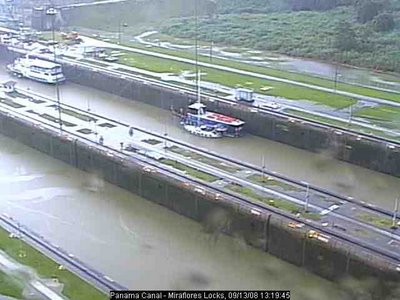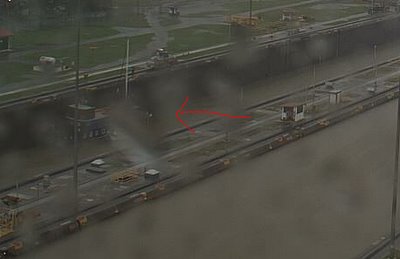Join Dave and Sherry on their cruise around the world on their St. Francis 44 catamaran.
(Currently hanging out in Malaysia, getting the boat ready for the jump to the Mediterranean in 2026)
Friday, September 26, 2008
Canal Recaps & Pics Posted
You can see them all together at this link: Panama Canal
Wednesday, September 24, 2008
The Flamenco Anchorage, Balboa, Panama
We stopped in here for a few days to let off passengers and pick up a few things before we start moving NW toward Golfito, Costa Rica.
The favored anchorage seems to change depending on the season, as the prevailing winds change.
For the rainy season, the anchorage is on the east side of the causeway that the Balboa Yacht Club is on the west side of, at the Pacific entry to the Panama Canal. As shown by the anchor in the Bauhaus guide, you tuck up on the north side of the Flamenco Marina area.
The only dinghy dock is at Flamenco Marina, and they charge $5.25 per day, somewhat loosely enforced (ie you definitely have to pay on your first visit, but they're not super strict about checking your receipt all the time. Some cruisers told us you could get by paying a few days at a time, and then skipping a few days). The dock is a nice floating dock and very secure.
There is supposedly a $5/bag trash fee, but we have yet to be asked for it when we have dropped trash off. That may only be for boats getting rid of trash without paying for the dinghy dock.
There is a water hose at the dinghy dock, so you can fill jugs in the dinghy. Right now the dinghy area is at the far end of the fuel dock (in and to the left). There is a blue rope that designates the dinghy area, though even now in the low season, there's not enough room there for all the dinghies.
Note: Though the sign says Flamenco Marina, the official name according to the receipt we got is the Fuerte Amador Resort & Marina. Dockage is available at $1.65/foot short term and $1.50/foot long term.
The first time we anchored, we anchored south of where the Bauhaus guide showed, closer to the actual marina breakwater. This was fine for a day or so when the wind was very light. But when the wind came up just a little (10-12 knots), it got very rolly there. So we moved a quarter mile north to where Bauhaus shows the anchor. It is further from the dinghy dock, but much less rolly here. There is a large area, good holding, with about 10-15 feet at low tide.
Internet access: I can see the marina wifi out on the hook with my good wifi setup, at our first anchorage near the marina. But couldn't get anything free/open out there. The only usable hookup was the Flamenco Marina hotspot (nice strong signal), but when hooked up, you get a logon screen. When I asked at the marina about a logon, we were told that the marina internet connection is terrible, so don't bother paying for it. There is free wifi at the Flamenco Cafe and at Bennigans, both right at the marina. It is slow... probably the same feed that you have to pay for on the marina's wifi. I have not pursued a faster alternative ashore.
When we moved further down to the regular anchorage, I started picking up the Whisper hotspot. This is a 'for pay' hotspot, and you can buy 2 hrs for $5, or 15 hrs for $20. At $1.25/hr for reasonably fast wifi on the boat, I think it's a good value. (Dave said "Twenty dollars!!") You can sign up on their website with a credit card, or call the number on the webpage, or find a physical outlet (the shops/restaurants ashore in the shopping center, probably... we haven't been there). I just used my credit card. So far haven't regretted it, though it is probably a little bit risky over an unsecured wireless link.
There is fuel at the Flamenco Marina. It is way cheaper than it was at PCYC in Colon, and a little cheaper than BYC. It does a huge volume with the sportsfishing boats, so the fuel is very good.
There is a mini-mart at the marina, across from the office. It has basic stuff you'd expect at a marina-based mini-mart (no veggies).
There are taxis hanging out at the marina parking lot. We met one who was very nice, with a/c taxi, speaks english. Ramon's cell is 6452-7157. It's $30 to the international airport. Ramon will do 'by the hour' taxi $10/hour and he knows most of the places that the cruisers want to go.
There are buses that stop at the marina but as yet do not have any experience taking them yet. We understand that the route here either ends near the Albrook Mall or at Centro Commercial.
Saturday, September 20, 2008
The Pearl Diving Submarine in the Perlas Islands

Though everyone, including the cruising guides, refer to it as 'the Japanese submarine', we understand that it is really a 1860's pearl-diving submarine.
A marine archaeologist friend of Dave's by the name of Jim Delgado was here in 2001 and thought it didn't look very Japanese-like. He was very familiar with Japanese sub construction after spending years in the Pacific documenting Pacific WWII ship wrecks.
After encountering the sub on the beach while on vacation, he researched it some more and after spending time here again in 2002 and 2004 with several friends, including Larry Murphy formerly of the National Park Service, he eventually established that it was a "lost" pearl-diving submarine, 'Sub Marine Explorer', built by a German engineer in 1865. It is one of only 5 surviving submarines built before 1870. Read about the find here. Jim Delgado, the archaeologist, is a former historian with the US National Park Service, and is now the director of the Vancouver BC Maritime Museum. He and Dave worked together in the Pacific in the late 1980s, documenting Japanese wrecks.
To sum up the history of the Sub Marine Explorer... a German engineer, Julius Kroehl, built the sub in 1865 to do pearl diving in the Las Perlas islands. But they didn't know about 'the bends'... a problem that occurs when breathing compressed air at deep depths and then surfacing without properly decompressing. The boat arrived in Panama in Dec 1866 and did make several successful pearl dives to deep depths, but by Sep 1867 the engineer and all the sub operators died of 'the bends'. The next/last documented attempt to use the sub occurred in August 1869 when over a period of 11 days it recovered $2K worth of pearls (a LOT of money in those days). But again, soon after, all its crew died of the bends. The sub was then was abandoned, apparently beached on San Telmo and left for good.
The Bauhaus Panama guide book mentioned the sub, but only that it was a Japanese sub on the north side of San Telmo. So we got on the VHF and got a waypoint from s/v Carina. Our Tides & Currents 3.0 program seems to be pretty accurate, and it indicated that low tide was about noon. So we set out from the Punta Cocos anchorage (S end of Isla del Rey) and arrived right about noon.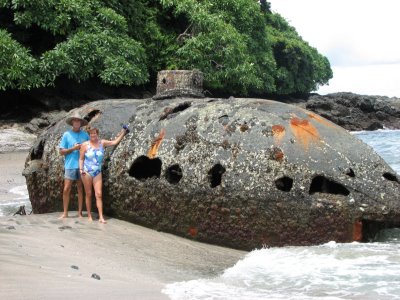
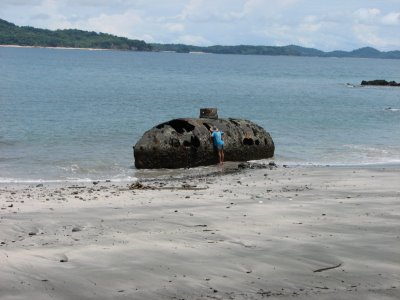
The sub was clearly visible on the beach at low tide, but would be covered at high tide. It was shaped like a fat cigar and is pretty large. I am amazed at how well-preserved it is after sitting in salt water for 150 years. We took a zillion pictures and will post some here as soon as we get internet.
Sub position: 08-16.896N 078-50.743W
Our anchorage: 08-17.050N 078-50.801W (day anchorage only, in settled weather)
There is an uncharted rock/reef outside/north our anchored position that was visible at low tide at APPROX 08-17.136N 078-50.815
On a settled day with a fast dinghy, you could also dinghy to see the sub from the Punta Cocos anchorage.
Friday, September 19, 2008
Whale Ho!!!
We are really excited to be in whale territory. We have had numerous sightings so far of huge humpbacks, though we don't have a great picture to post yet.
Once when we were sailing, we sighted a whale about 200 yards directly in front of us. Dave was worried about colliding with it, but it sank out of sight before we got close. You could see the swirls in the water where he had flipped his tail when we went over the spot.
One night, in the Isla Pedro Gonzales southeast anchorage, they were playing in the swirl of current going by the point. Doing what we called 'Tail Flops'. They stand on their head and whack their tail back and forth on the surface of the water. Very impressive. No pics of this, as it was at night (but enough moonlight to see that it was whale tails making the smacking sounds).
On our final night in the Perlas, we were anchored on the north side of Isla Contadora, and were treated to a show by a couple of whales going by the anchorage.
Thursday, September 18, 2008
Our New Code 0 Sail
Dave has been talking about getting a Code Zero sail ever since I met him. On our first date, he showed me the Facnor roller furler that he had just purchased for it.
We have looked on all the used sail sites on and off for the past 2 years, and have been unable to find a used sail that would work. And by the time you buy it used and have it modified to do what we want with it... We talked to a few sailmakers at the last St. Pete boat show, and got some quotes. They were pretty expensive (in the $2000-$4000 range), so we put off doing anything.
But as the price of diesel fuel has been rising, and as we've been motoring around in light winds all summer long, we finally justified the expense by talking about cost savings at approx $4.50 per motoring hour here in Panama and probably more than that out in the South Pacific.
So with the ability to ship stuff to Panama pretty easily via Marine Warehouse, we went ahead and ordered a new Code 0 from Dave's favorite sailmaker (SuperSailmakers in Ft. Lauderdale, a Doyle loft). We took delivery of the sail in Colon just before we left... didn't even have a chance to get it out of the bag, though.
Finally, sitting on the mooring in Balboa, Dave hauled it out and he and Jim Yates (one of our visiting line handlers) rigged it up and got it rolled onto the furler.
With great anticipation, we rolled it out on our way to Taboga. It seemed the conditions were perfect... light winds on the beam.
It lasted about 10 minutes before the wind came up a little and broke the block at the top of the mast. Rats! And with the rise in wind came a wind shift... on our nose again.
The next day before we left the mooring, Dave found a replacement block and went up the mast to replace the broken one. (The cheek broke).
But on our way from Taboga to Contadora, the wind was almost on our nose the whole way. And, the distance was 40 miles to the closest anchorage, so we couldn't afford to stay out there messing around with sails all day. So we motored again. But we did notice that the lower attachment point of the sail, on our anchor tray, as far forward as we can put it, wasn't working out as anticipated. (the tray was lifting off the frame as we tensioned the luff).
So yesterday, hanging out at anchor at Isla Pedro Gonzales, Dave and Ron and Jim engineered a cobbled-up fix to the problem. I was busying doing other things, but there were sawing and drilling noises coming from the workshop. I'm sure Dave will explain the final solution when we have it working well. About dusk they seemed satisfied that what they had whipped up would work for now.
We are hoping to be able to sail today. We have 20 miles to go to the next anchorage.
Isla Taboga, Panama
We arrived on Sunday afternoon, and understandably, the harbor and the beach was pretty full of power boats from Panama City. As far as we could tell, everyone was on a mooring.
We hadn't thought to ask anyone about Taboga specifically, though we had gotten several tips from some new friends on Rhapsody on where to go in the Las Perlas (Pearl) Islands. The only cruising boats we could see in the harbor looked unoccupied. Where there were no moorings, it was over 50 feet deep (at high tide). Even the outer harbor had 4-5 large (about 200 feet long) Tuna boats.
Finally we saw a dinghy coming out from shore to a power boat on a mooring. They looked like cruisers and not locals. We idled over nearby and asked them about anchoring and/or mooring. They recommended we call 'Libre' on channel 74 and ask about a mooring. We called a couple of times, but didn't get an answer. Then we heard Rhapsody, back in Balboa, calling us and telling us to go to 77. We still aren't quite sure exactly why, since Libre was close ashore somewhere, but Rhapsody (8 miles away)
could hear Libre answering us. So they relayed for us and directed us to a mooring.
Later, Chuy and Susan from Libre stopped by in their dinghy. They are a cruising couple from California who have put down roots at Taboga, and they now run 'Taboga Island Moorings'. You can call or email ahead for a mooring at 507-6442-5712 or chusanandlibre@hotmail.com. They also do 'boat sitting' for people who need to leave the boat for a little while.
We didn't go ashore. It looked like a small town with a resort atmosphere... there is regular ferry service to Panama City/Balboa, and cell phone service, and even wifi. It's very popular with the Panamanians on the weekend, but gets a little sleepy on weekdays.
It was a nice enough anchorage, but a little rolly (our mooring was pretty far out). The only really bad thing was that the tuna boats ran their generators and lights all night long.
Isla Contadora, Las Perlas, Panama
Anchorage Position: 08-37.91N 79-02.39W
We left Taboga about 8:30 for the 40 mile run to the Las Perlas islands. We had chosen an anchorage on the north coast of Contadora, because someone told Dave that there was good diving there. The guidebooks talk a lot about the winter weather, but they don't say much about the summer weather. And we don't know the normal weather patterns here.
We had a nice day motoring across. We trolled two fishing lines, and did get several hits, but all the fish we pulled in were Bonito, which aren't very good eating.
When we arrived at the anchoring spot, it looked OK. Here again there were moorings in the anchorage, but also a couple of anchored cruising boats. So we picked a spot between empty moorings and anchored in 25'. Checking my trusty electronic tide table, we were at high tide, with a 15 foot tidal range. That means that at low tide, our 25' depth will shrink to 10' !!!
During the evening, dark clouds started to build. We had a pretty good lightning show after dinner. We were a little apprehensive about what the weather might bring during the night. But the weather held until early morning, when we really got hit... hard rain and lots of lightning and thunder very close by. We filled our water tanks and put the valuable electronics in the oven. Fortunately, no direct hits from the lightning.
The forecast was for strong SWly winds, and we were a little exposed to the SW. We heard a couple of boats on the net talking about Isla Pedro Gonzales. We remembered reading an SSCA letter from another cruiser saying that Pedro Gonzales was the best anchorage they'd seen on the whole west coast of Central America.
So when the rain let up, we set off for Pedro Gonzales.
Monday, September 15, 2008
Balboa Yacht Club
A few facts:
- Only moorings there (no room to anchor right in this spot) - $22/night plus 5%
- Wifi available in the mooring field
- Free lancha, so you don't have to put your dinghy down
- Nice bar and restaurant
- BYC stands by on VHF 06
- The local cruisers are on VHF 74 and there is a net 8am every day except Sundays
- The HF net on this side is the Panama Pacific Net on 8143 USB, at 9am local time
We had to leave by Sunday afternoon, because Dave opted to check out of Panama at the Colon Yacht Club for Costa Rica (with intermediate stops), when we left Colon.
It was either that or check out of Colon for Balboa and have to check out of Balboa (another expense) later. What we didn't know when we made that decision was that we'd have to check out of Balboa, immigration-wise, within 48 hours of getting our Zarpe in Colon (or face a fine, or have to check back into Balboa). We were hoping the Balboa Immigration guy would let us stay til Mon morning, but no such luck.
So we left BYC yesterday and sailed 9 miles SW to the island of Taboga.
Panama Canal - Locking in the Rain
Sunday, September 14, 2008
Panama Canal Transit - Our Crew
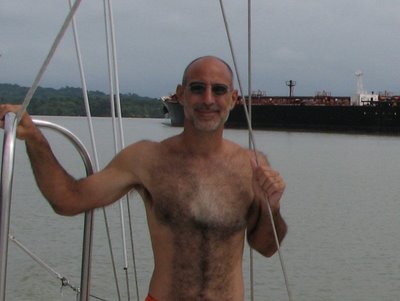
The pictures on the Panama Canal and Las Perlas sections of the blog have been taken by one of the above people. We had 5 people and 7 cameras!!! Thanks crew for the help, the pics, and the memories!! See you in Tahiti!!
Panama Canal Transit - Day 2 Recap
We were up and ready to get going by 6:30am, as instructed. But our advisor didn't get there til about 8am. We got underway immediately and took the 'Banana Cut' route. It is a small boat channel, and saves about a mile and a half. We had about 25 miles to go to the next lock (Pedro Miguel), and an appointment for 12:30. So we had the pedal to the metal the whole time, even cutting corners on the wide sweeping channels (at the direction of our advisor) to save time. It was a pretty trip but I didn't see much of it... I was too busy feeding people. Jim and Dorothy took lots of pics. I was making breakfast and lunch, mostly.
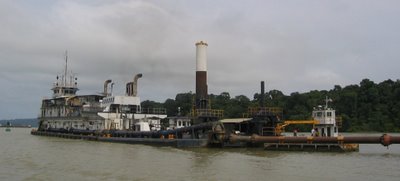 Dredges Keeping the Channel Open
Dredges Keeping the Channel Open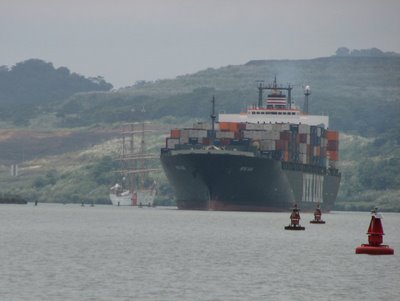 Ships Passing By in Channel
Ships Passing By in Channel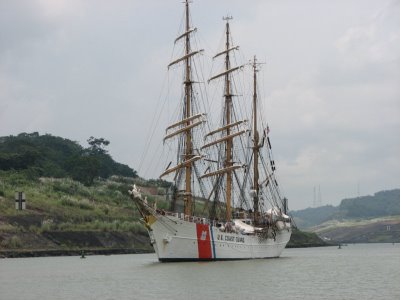 The USCG Training Ship Eagle
The USCG Training Ship Eagle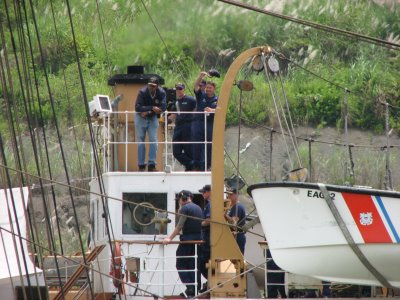
The down locks on the Pacific side are two sets of locks... Pedro Miguel and Miraflores, about a mile apart. I think there are 2 chambers in Pedro Miguel and 3 in Miraflores. As we started into the first chamber at Pedro Miguel, the dark storm clouds that had been gathering finally opened up. It absolutely poured on us for the entire time we were in the locks.
As we pulled out of the last chamber at Miraflores, the rain quit. Our advisor (who had said, when Dave asked him if those dark clouds were going to rain on us, "No.") said he had never been in the locks in such heavy rain. He was not dressed for it... he had a jacket but it was more a windbreaker than a heavy rain jacket. At one point, once we got secured, he gave his radio to us to keep it dry (they are special radios on special frequencies, not standard VHF).
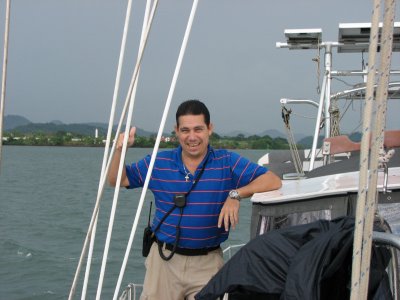
Once you exit at Miraflores, you are only a few miles from Balboa Yacht Club, passing under the famous Bridge of the Americas.
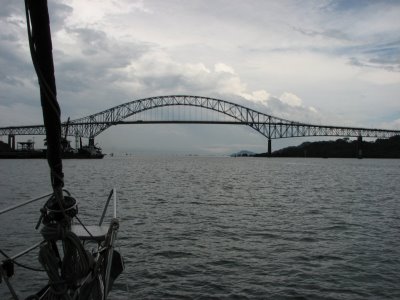
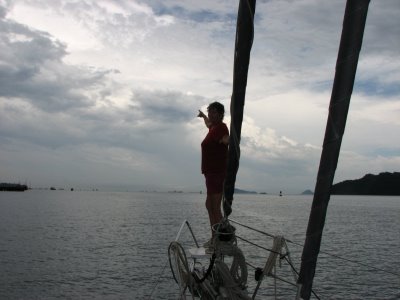 Onward To The Pacific!!!
Onward To The Pacific!!!We had called ahead on the phone a couple of days before to get a mooring at Balboa Yacht Club. They don't take reservations, so we called the afternoon before and again the morning of. Fortunately this time of year it's low low season, so there was a mooring available. For $25 a nite, it's not bad... convenient. But not absolutely necessary.
Now that we've been in the Flamenco anchorage, that would be perfectly fine too. (The Flamenco anchorage, at least this time of year, is around on the other side of the causeway from BYC, pretty much right where Bauhaus shows it). In the Flamenco anchorage you pay $5.25 per day for dinghy dockage, for a floating dock with security. They supposedly have a $5/bag trash fee, but we've never been asked for it yet. Dave thinks the dinghy dock fee is reasonable, and apparently there's no way around it... we've asked several people and there seems to be no other place to leave your dinghy on this side of the causeway. But someone else told us that they don't enforce/check your receipt. So if you pay for a few days at a time, once a week or so, you can cut your costs by a third to a half. However, you know Dave, he insists on following the rules, so we are paying for every day.
Customs/Immigration issues... You have to get a zarpe for somewhere when you leave Colon. Your choice is to zarpe to Balboa, and then pay for another zarpe later to leave the country, or zarpe onward to whereever you are going next. For us, that was Costa Rica. For only $20, Tito in Colon got us our onward zarpe. Versus paying about $50 in Balboa on top of a $20 zarpe for Colon to Balboa. What we didn't realize when we made the decision was that, once you have your international zarpe, you have 48 hours to clear immigration and (theoretically) leave Balboa.
There is an immigration guy at Balboa Yacht Club, and our 48 hours was up at 5pm the day after we completed the transit. Dave asked him if we could stay overnight and leave in the morning, but he said we had to leave that day. With him right there, we couldn't really stay. So we left for Taboga that afternoon (only 7 miles away).
Panama Canal Transit - Day 1 Recap
On the lock up, we were supposed to 'side tie' to another vessel. That's what Dave requested when we scheduled our lockage, and that's what the plan was when the Advisor got on board. He even pointed out the boat we were going to tie up to (the Islamorada, see pics in another post)
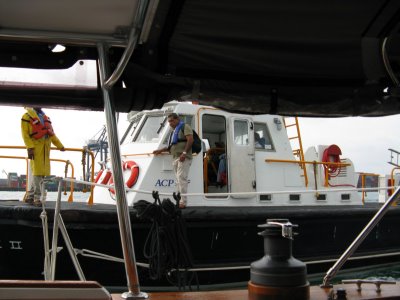
But as we were getting lined up for the first lock, he said the plan had changed. It was something about that it was not safe to have 3 small boats AND a big boat in the locks at the same time. And we were the last guy/smallest boat. So we got bumped to the other lock (there are 2 locks side by side) doing what's called 'center chamber', behind a big ship. (They always put the small boats behind on the up-locking and the small boats in front on the down-locking).
The reason you want to request 'side tie to a tug' is that you raft up to the tug (or larger vessel) and THEY handle the lines along the wall. We just tie up to them. It's much easier for the crew on your own vessel. (As long as the crew on the other vessel is competent.)
'Center chamber' meant that we had to work... They put us in the middle of the chamber, behind the big ship. We had our 4 long lines out bow and stern, and then we had to keep tightening the lines as the water rose.
As we approached the lock, we had our 125' lines ready with a loop in one end and flaked out on deck, with the bitter end secured to a cleat. The Canal line handlers up in the lock threw us a monkeys fist tied to small line, and we tied that around our loop, and they brought the loop up to them and dropped it on a bollard. Then we tended our lines as the water rose.
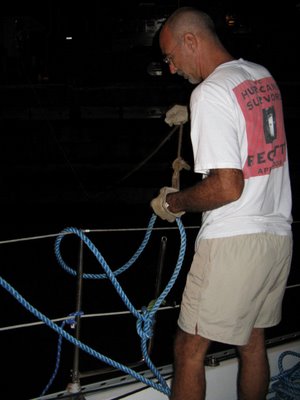
It was really hard work... the lines are so thick and stiff that we had to pull the slack in on the line with one hand and take it up around the cleat with the other, bending over the whole time. Because of the way the water comes in, it pushes the boat from one side or the other, so usually only the lines on one side or the other of the boat get any slack in them. The boat line handlers on the other side just keep their line secure.
In the first chamber, Ron and I were on the stern, and I did all the work. Ron gallantly offered to switch sides with me for the next chamber, and I gratefully switched sides with him. But the direction of the 'push' switched sides too, so I had to work again.
Dorothy, up on the starboard bow, had a little trouble getting her line secured at the first chamber, but we had Jim Yates on the bow with her, and the advisor was right there helping out a little also. By the second chamber, we were all 'old hands', and had no further problems.
Locking up at night wasn't hard. We took the advisor onboard at 5pm and got to the approach area of Gatun Lock about 6pm. We had to wait for the other boats (a large ship and 2 other smaller boats). We got to the first chamber before dark, and then once in the locks, it's all lit up.
When we got thru the last chamber at Gatun Locks and went out onto the lake, it was pretty dark out there. Though our advisor knew about where it was, and it would show up on radar, a waypoint for the bouy would have been useful.
Gatun Lake Sailboat Bouy: 09-15.665N 079-54.138.
There are two huge moorings there, and at least 4 35-55' boats could raft up to the two, easily. The moorings are so big that you don't tie off to it from the bow, but actually side tie (raft) to it.
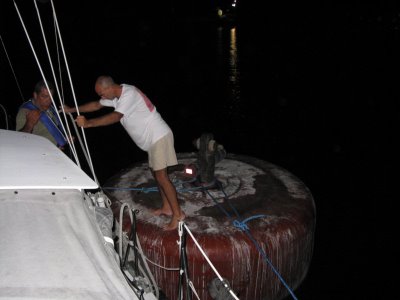
We finally got secured about 10pm, and the pilot boat showed up about 10 minutes later to take our advisor off. The Soggy Paws crew had a congratulatory drink and a snack, and went promptly to bed.
We were the only boat we could see on the lake. The other two smaller vessels that we were supposed to have been locking through with... a large fishing vessel and an excursion boat (the Islamorada) had gone on. Unfortunately, it's not as exotic and remote as it sounds... The mooring was off some kind of maintenance facility that was also pretty lit up. But we did hear a very loud troupe of howler monkeys on shore. We looked for, but did not see, crocodiles.
In the Pacific Ocean!!!
With 4 cameras aboard, we took about a billion pictures yesterday and today. I will post a few very soon.
But we are now on a mooring at Balboa Yacht Club in the Pacific Ocean. Yahoo!
No problems on the transit (other than getting very wet handling lines). We had good advisors (one last night and one today).
Thanks, Nicki... great job posting. Sorry about the raindrops on the camera... it poured rain the whole time we were in the Pedro Miguel & Miraflores locks. (and quit just as we pulled out of the locks).
Crew is celebrating. More tomorrow!
Saturday, September 13, 2008
Panama Canal: Tracking Post
8:45 PM EDT: Soggy Paws entered the first Gatun lock (east). They are behind a ship?
9:30 PM EDT: Entered the 2nd lock. Waving at the cameras!
10:50 PM EDT: Done for the night.
Gatun locks: 8:15 PM EDT
UPDATE: Current ETA at Gatun is 8:15 PM EDT, east locks.
Friday, September 12, 2008
Pilot Time: 5pm (6pm EDT)
But for now we are planning to have all our stuff done by 3pm. Dorothy is working on a last load of laundry for everyone. Ron and Jim are inspecting the lines we got yesterday from Tito. Dave is working on paperwork... getting our Zarpe and paying our bill at PCYC. I am cooking a big stew for the crew and our 'Advisor'.
I'll do another post when we confirm the pickup time (about 2:30pm Local Time.. add 1 hour for EDT).
Nicki has promised to do another post when we start through the locks at Gatun, but we will probably be going through about 6pm local, 7pm EDT.
The Gatun Locks webcam
Stocking Up
In the past week, we have bought 5 cases of rum in liter bottles and 3 cases of wine in liter boxes. And another $300 worth of groceries (that's on top of the $500 we bought 3 weeks ago).
And yesterday we did a final shopping, with friends Jim Yates and Dorothy Sheridan along. Everyone got a chance to see what a good Panamanian grocery store is like, and pick out their favorite brand of cereal, etc. (Meanwhile Dave and Ron were back at the boat swapping water maker pumps).
Stowing all that stuff has been fun, especially with Dave and Ron still with their heads in the engine room, and all the 'stuff' that normally lives in V-berth out in the salon.
On advice of some friends who have preceded us across the Pacific, we decanted 36 liters of rum into 2 5-gallon water containers. This makes a very space-efficient storage location, no glass, no cucaracha-laden cardboard boxes, only the weight of the rum itself. It also makes the rum less visible and therefore less likely to be taxed or confiscated by a Customs guy. The rest of the rum was 'socked' (each bottle put in 2 old socks for protection) and stored in nether lockers.
We bought our rum from a local guy who came out to the marina with a brochure, and he delivered it 4 hours later. (Umberto 6706-1015). We paid cash on delivery, $60/case for the good stuff and $45/per case for the mixing rum. Plus a $10 delivery fee. He has lots of other liquor in his brochures, and will sell individual bottles.
The boxed Clos brand wine (from Chile) we just bought at the grocery store for $2.09 per liter. That's a heckuva deal. There are better wines, but if you stop drinking 'the good stuff', the Clos is very drinkable, and the price is right. And this stuff is so much more convenient than wine in bottles. No bottle to break, less weight, much better storage form factor and much easier stowage. We put most of the wine under our bed. Dorothy did a great job of packing things around in there (while I was stowing stuff in the fridge).
Note the boxes of Triscuits... Jim Yates brought a case with him from the States. That is one of the few items we have been unable to find in Panama.
So we are well stocked, with plenty of food for the 5 of us for the next 10 days, and then enough staples to last Dave and I quite a long while.
Thursday, September 11, 2008
Sightseeing a Little
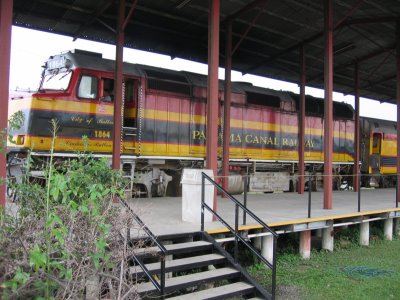
It was partially a sightseeing trip, partially to go 'collect' 2 of our line handlers (Ron and Dorothy Sheridan) and partially to get a few things in Panama City.
Though taking a bus is the cheapest way... The bus departs once an hour from the Colon bus terminal near the marina, and only costs $2.50 for a luxury A/C bus with movie.
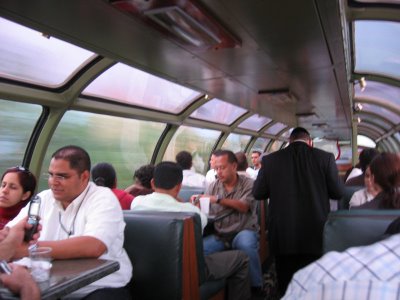
We opted to take the train. The train makes a round trip from Panama City daily, leaving Panama City about 7am and returning from Colon at 5:15pm. We originally thought is was totally a 'tourist train', but found out that it has a practical purpose. It brings workers from Panama City to Colon, primarily staff of the Free Trade Zone. Apparently the employers lease cars on the train to bring their workers back and forth.
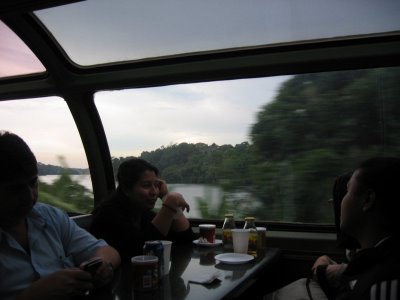
Only one car on the train is for the tourists, a nice observation car. It fills up quickly, so we were glad we got there early (about 4:45pm). It was a nice 1 hour ride to Panama City.
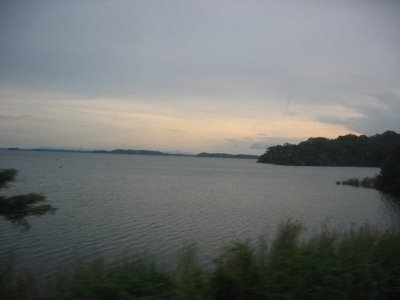
We stayed overnight in La Estancia, a small bed and breakfast situated in what used to be Officers Quarters on Ancon Hill. This is a nice setting, close to the city, but away from the city. At $70 it is a little higher than we usually choose to pay, but breakfast was included and it was really a nice place (hot water, very good beds, nicely kept). There were birds and monkeys in the trees.
Dave and I did some running around in Panama City early in the morning. When Ron and Dorothy arrived, we all headed out to Miraflores Lock to have lunch and see the museum. We also got to see a ship transiting the lock.
Tuesday, September 9, 2008
Dirty Nasty Colon, Panama
The Panama Canal 'Yacht Club' is living on borrowed time. Everyone expects that eventually the port operations will force them out. So the yacht club facilities have been allowed to decline. The docks are OK but the building is old and dirty.
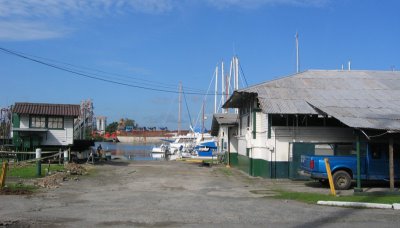
The facility has been totally surrounded by the industrial shipping operations.
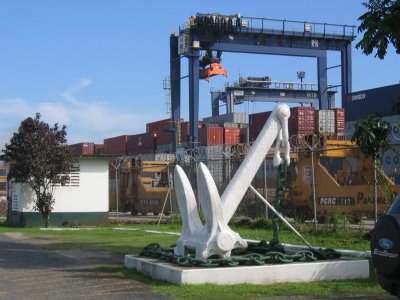
We currently have a ship just across the canal that is unloading powdered cement. They drop a big scoop into the hold and bring it up and across into the back of an open semi truck. The wind has been blowing from the ship directly toward the yacht club. So EVERYTHING is coated with a layer of cement dust. I have never seen Soggy Paws so dirty. It is driving Dave crazy.
Also, with the wind blowing from the docks, yesterday we got a large slug of diesel fuel down in our corner of the marina. It was a large spill... or someone flushing their bilges. No one seems to care here.
And did I mention the dump? The Colon dump is nearby. It's not too bad except when it catches fire. Then a stinky smoke hangs over all of downtown Colon and the marina. It was on fire last night.
And the crime? The Colon bus station is only about 2 blocks away, but its not safe to walk there. In the area along where you'd walk is lined with apartment building that in the States would be called slums. Everyone has anecdotes about cruisers getting mugged, robbed, and at least one guy was knifed 17 times. We take a taxi. At $1 it's reasonable (or $10/hour to take you around town).
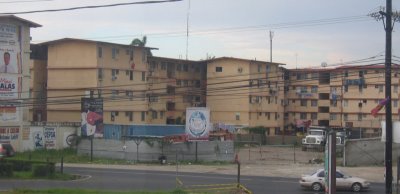
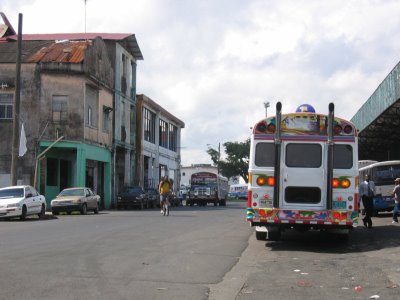
All that said, the facility is convenient for transiting the Canal and for provisioning. It is only a $1 taxi ride to get to several huge grocery stores. And of course being able to order stuff from Panama City and the States via Marine Warehouse is very useful.
But I can't wait to get out of here!!
